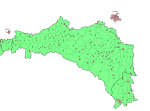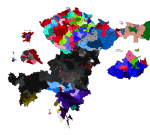Okay, I'm not going to cut out Galicia from the overview maps and upload it again just so I can make this description a bit more readable. Go look at them, they're just a bit further up on this page.
The Kingdom of Galicia and Lodomeria was one of the three Austrian crown lands to be styled a kingdom, along with Bohemia and Dalmatia (formerly also Illyria, but we're not counting that since it was dissolved in 1848 and split into several different new provinces). In essence, it covered the lands gained by Austria during the Partitions of Poland, with the exception of the areas given over to Russia in 1815, and at 78,000 square kilometres and around eight million inhabitants, it was the largest and most populous Austrian crown land excluding Hungary. It included the ancient Polish capital of Krakow, which had been a city-state but was annexed by Austria in 1848, as well as the multicultural city of Lemberg (Lwów/Lviv), which was both its capital and largest city. In addition, it included most of the northern side of the Carpathian Mountains, with significant mining traditions in some of its mountainous regions, as well as a large chunk of the Central European Plain. A narrow majority of the population - around 55% - spoke Polish, with another 40% or so speaking "Ruthenian" (the Austrian catch-all term for any Eastern Slavic language not clearly identifiable as Russian, so mainly Ukrainian but also various Rusyn dialects in the mountains) and the rest being a mix of German, Yiddish and other trace minorities. Around 10% of the population cited their faith as Jewish, a number that got as high as 25% in some districts, but as far as I can tell, the Austrian census did not include Yiddish as a language option, and most of the Jews did not claim to speak German, but rather whatever language the local goyim spoke, usually Polish. There was also a large Roma community, which as you might expect just didn't show up on the census at all, at least not as an identifiable group.
Although the Poles were only a slight majority of the population in Galicia, the region's history as part of the Polish-Lithuanian Commonwealth meant that the Polish
szlachta (nobility) held a tight grip on almost all positions of authority in the province. By and large, at least after 1848, the Austrian authorities supported them in this, and from 1861 onwards, a diet (
sejm krajowy) was set up in Lemberg to govern the province. Elected through roughly the same curiate system as all the other Austrian provincial diets, this body was dominated by the
szlachta from the very beginning, and while the peasantry began to assert itself in the later years, it was never enough to shift power entirely away from them. Polish (and, to some extent, Ukrainian) intelligentsia did quite well in Galicia, where there was little of the repression and censorship that characterised life in Russian Poland nor the economic pressures exerted against Poles in Germany, and the region would give the interwar Polish Republic many of its leading figures and political movements. For the peasantry, it was quite a different story - poor education, inefficient agriculture and neglectful local authorities caused such pressure on the lower classes that "Galician misery" (
nędza galicyjska) is still a familiar word for extreme poverty in the Polish language today. By 1900, the province was in such dire straits that for many, especially the Jewish population, their only viable option was to emigrate.
Another oddity about Galicia was the fact that it was the only province to have its own electoral system for the Reichsrat. There were significant differences in how the constituencies were drawn from one place to another, but in Galicia the rural constituencies actually elected two members each, with the result that the province only had 70 constituencies for 106 members. This was officially to allow representation for minority groups in ethnically mixed areas - in practice, since the west tended to be almost entirely Polish while the east was a mix of Poles, Ukrainians and Jews, this had the added bonus of diluting the representation of Ukrainians and allowing Poles to take 78 out of 106 seats in the 1907 elections. In fact, "Ruthenians" were the single most underrepresented ethnic group in the Reichsrat, with 102,470 people per representative, compared to 49,680 on average for the whole empire. Of course, part of this is due to Galicia itself being underrepresented, as the Reichsrat was apportioned based on tax revenue, which was not good news for a province characterised by endemic poverty and famine.

(election results to be added later)







